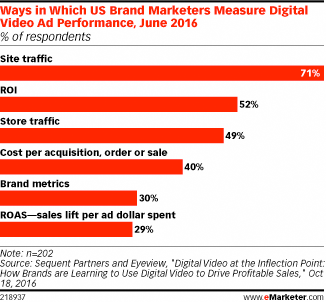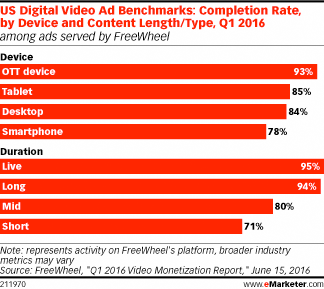How Brand Marketers Measure Digital Video Advertising
November 15, 2016
![]() US brand marketers gauge how well, or otherwise, their digital video ads perform in a variety of different ways. Today, most measure digital video ad performance by looking at site traffic, June 2016 research indicates, but in the next year or two, more respondents want to be able to measure via cost per acquisition.
US brand marketers gauge how well, or otherwise, their digital video ads perform in a variety of different ways. Today, most measure digital video ad performance by looking at site traffic, June 2016 research indicates, but in the next year or two, more respondents want to be able to measure via cost per acquisition.
 Brand and media consultancy Sequent Partners and Eyeview, a video marketing technology company, surveyed 202 US brand marketers who worked in the automotive, CPG, retail and travel industries. Respondents all worked for companies that currently buy digital video ads and are involved in their company’s media budget setting and allocation process.
Brand and media consultancy Sequent Partners and Eyeview, a video marketing technology company, surveyed 202 US brand marketers who worked in the automotive, CPG, retail and travel industries. Respondents all worked for companies that currently buy digital video ads and are involved in their company’s media budget setting and allocation process.
Nearly three-quarters (71%) of brand marketers said they currently determine their digital video ad performance by watching site traffic. And more than half of respondents said they look at their return on investment (ROI). Brand metrics, as well as store traffic, are other ways they currently measure digital video advertising.
 When asked how would they want to measure it in the next year or two, site traffic was still the top measurement mentioned. Indeed, 73% of respondents said they would want to measure it that way. Meanwhile, 38% of brand marketers said they would want to measure digital video ad performance by looking at the return on ad sales (ROAS). To compare, just 29% of respondents said they measure it that way today.
When asked how would they want to measure it in the next year or two, site traffic was still the top measurement mentioned. Indeed, 73% of respondents said they would want to measure it that way. Meanwhile, 38% of brand marketers said they would want to measure digital video ad performance by looking at the return on ad sales (ROAS). To compare, just 29% of respondents said they measure it that way today.
And one of the biggest differences was that nearly two-thirds of brand marketers said they would want to measure digital video ad performance by the cost per acquisition, order or sale. Only 40% of respondents said they do just that today.
Measuring effectiveness across devices and content platforms is not a one-size-fits-all endeavor. June 2016 research from ad tech firm FreeWheel of ads on its network found that completion rates were better with larger screens and longer content. In Q1 2016, completion rates for US digital video ads on over-the-top (OTT) devices such as connected TVs were 93%, compared with 78% for smartphones and rates in between for tablets and desktops.
Courtesy of eMarketer





























